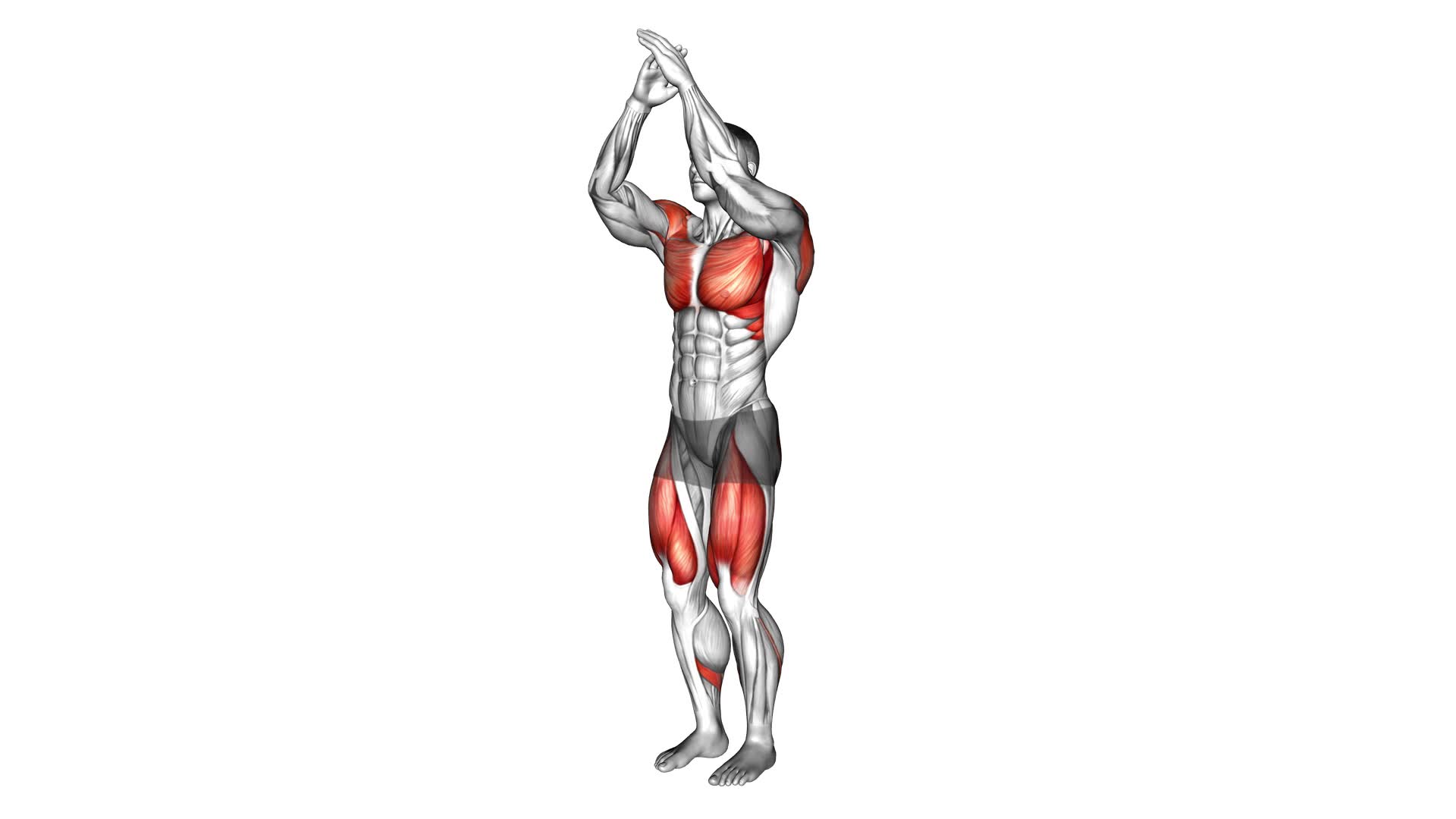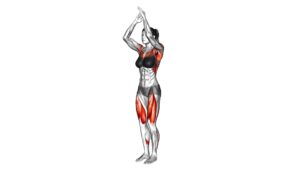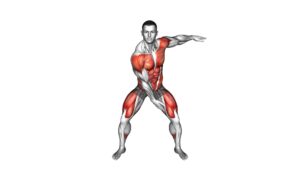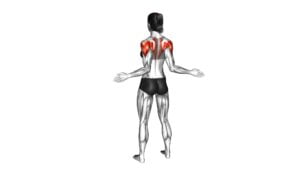Bouncing Circle Draw (male) – Video Exercise Guide & Tips

Are you ready to take your workout to the next level?
Watch This Exercise Video
Get ready to master the Bouncing Circle Draw exercise.
In this video exercise guide, we'll show you how to properly perform this challenging move, targeting your core and upper body.
With our tips and techniques, you'll be on your way to a stronger, more toned physique.
So grab your mat and let's get started!
Key Takeaways
- The Bouncing Circle Draw exercise targets multiple muscle groups and provides a full-body workout.
- It engages core muscles, including abdominals and obliques, as well as shoulders, chest, back, glutes, and quadriceps.
- It can be incorporated into a workout routine as a warm-up exercise and progressed by increasing sets or adding resistance.
- The exercise requires a stability ball for support and balance, but alternative options such as a medicine ball or yoga ball can be used.
Benefits of the Bouncing Circle Draw Exercise
There are several benefits to incorporating the bouncing circle draw exercise into your workout routine. Not only does this exercise target multiple muscle groups, but it also helps you achieve a full body workout. When performing the bouncing circle draw, you engage your core muscles, including your abdominals and obliques, as you rotate your torso. Additionally, your shoulders, chest, and back muscles are activated as you draw the circle with your arms. This exercise also targets your glutes and quadriceps as you lower into a squat position and push off the ground to bounce.
To incorporate the bouncing circle draw exercise into a full body workout routine, you can start by performing it as a warm-up exercise. Begin with a few sets of 10 to 12 repetitions, focusing on maintaining proper form and engaging the targeted muscles. As you progress, you can increase the number of sets or add resistance by using dumbbells or resistance bands. You can also incorporate the bouncing circle draw into a circuit training routine, alternating it with other exercises that target different muscle groups.
Now that you understand the benefits and how to incorporate the bouncing circle draw exercise into your workout routine, let's move on to the equipment needed for this exercise.
Equipment Needed for the Bouncing Circle Draw Exercise
To perform the bouncing circle draw exercise, you'll need a stability ball. This versatile piece of equipment is essential for this exercise as it provides the necessary support and stability to execute the movement effectively. The stability ball allows you to engage your core and challenge your balance, making the bouncing circle draw exercise an excellent choice for improving stability and coordination.
While a stability ball is the preferred equipment for this exercise, there are alternative exercises you can try if you don't have access to one. You can use a medicine ball or a yoga ball as substitutes, as they also provide the necessary stability and support. If you don't have any of these equipment options, you can modify the exercise by performing a seated twist or a standing twist with a medicine ball or a weight plate.
When performing the bouncing circle draw exercise, there are some common mistakes to avoid. Make sure to maintain proper form throughout the movement, keeping your core engaged and your back straight. It's also essential to control the bouncing motion and avoid excessive momentum, as this can compromise the effectiveness of the exercise.
Now that you know the equipment needed and the common mistakes to avoid, let's move on to the step-by-step guide to performing the bouncing circle draw exercise.
Step-by-Step Guide to Performing the Bouncing Circle Draw Exercise
To perform the bouncing circle draw exercise, you'll start by positioning yourself on the stability ball. This exercise targets your core muscles, improves balance, and enhances coordination. Follow these steps to perform the exercise correctly:
- Sit on the stability ball, with your feet flat on the floor and your knees bent at a 90-degree angle.
- Place your hands on your hips or extend them out in front of you for added stability.
- Slowly lift one foot off the ground and draw a small circle with your toes. Start with clockwise circles and then switch to counterclockwise circles.
- Maintain a steady and controlled movement, engaging your core muscles throughout the exercise.
- Repeat the movement with the other foot, completing the desired number of repetitions.
Common mistakes to avoid during the bouncing circle draw exercise include:
- Leaning too far back or forward, which can compromise your balance and stability.
- Performing the circles too quickly, which reduces the effectiveness of the exercise.
- Neglecting to engage your core muscles, leading to less stability and control.
Progressions and regressions can be made to suit your fitness level. Increase the difficulty by using ankle weights or performing the exercise with one leg at a time. To regress the exercise, perform the circles while seated on a chair instead of a stability ball.
Now that you know how to perform the bouncing circle draw exercise, let's move on to tips for proper form and technique.
Tips for Proper Form and Technique
Now let's focus on maintaining proper form and technique while performing the bouncing circle draw exercise. Proper form is crucial to maximize the effectiveness of this exercise and prevent injuries.
To start, make sure you have a stable and balanced stance with your feet shoulder-width apart. Engage your core throughout the movement to maintain stability and control.
One common mistake is using excessive momentum instead of controlled movements. Remember, it's not about how fast you move, but how well you engage the targeted muscles. Focus on the quality of each repetition rather than the quantity.
Speaking of muscle groups targeted, the bouncing circle draw primarily works your core muscles, including the rectus abdominis, obliques, and transverse abdominis. It also engages the muscles of your upper body, such as the shoulders, chest, and arms.
To ensure proper technique, keep your shoulders relaxed and your chest lifted throughout the exercise. As you draw the circles with the medicine ball, use your abdominal muscles to generate the movement, rather than relying solely on your arms.
Variations and Modifications for the Bouncing Circle Draw Exercise
For added challenge and variety, try incorporating different equipment into the bouncing circle draw exercise. By changing up your hand positions and incorporating resistance bands, you can target different muscle groups and intensify your workout.
Here are some variations and modifications to consider:
- Different Hand Positions: Instead of keeping your hands in a traditional grip, experiment with different hand positions. Try placing your hands closer together or wider apart to engage different muscles in your arms and shoulders. You can also try a neutral grip, with your palms facing each other, to work your forearms and improve grip strength.
- Incorporating Resistance Bands: Attach resistance bands to your wrists or the bar you're using for the exercise. This added resistance will challenge your muscles throughout the movement, making it more effective for building strength and endurance. Start with lighter bands and gradually increase the resistance as you get stronger.
- Combining Both: To maximize the benefits, you can combine different hand positions with resistance bands. This will create a greater challenge for your muscles and help you break through plateaus in your training.
Incorporating these variations and modifications into your bouncing circle draw exercise won't only keep your workouts interesting but also help you target different muscle groups and achieve better results.
Remember to always listen to your body and adjust the intensity as needed. Keep pushing yourself and enjoy the journey towards your fitness goals!
Frequently Asked Questions
How Many Calories Does the Bouncing Circle Draw Exercise Burn?
The bouncing circle draw exercise is a great way to burn calories and get in shape. It's a dynamic movement that targets your core, legs, and upper body.
The number of calories you burn will depend on factors like your weight and intensity level. To modify the exercise for low impact workouts, you can reduce the speed and intensity, or try performing the exercise on a softer surface.
Remember to always listen to your body and make adjustments as needed. Keep up the great work!
Can the Bouncing Circle Draw Exercise Help Improve Balance and Coordination?
Incorporating variations of the bouncing circle draw exercise into your workout routine can definitely help improve your balance and coordination.
This exercise involves drawing circles with your feet while bouncing on a stability ball. By challenging your core stability and engaging your leg muscles, you'll develop better balance and coordination over time.
Plus, the bouncing motion adds an element of fun and excitement to your workout, making it even more enjoyable and motivating.
Is the Bouncing Circle Draw Exercise Suitable for Beginners?
The bouncing circle draw exercise can be a great way to improve your balance and coordination.
But is it suitable for beginners? Well, the answer is yes!
This exercise can be modified to suit your fitness level.
Start by taking it slow and focusing on your form.
Remember to avoid common mistakes like rushing through the movements or losing control.
With practice and determination, you'll soon be mastering the bouncing circle draw exercise like a pro!
What Muscles Does the Bouncing Circle Draw Exercise Target?
The bouncing circle draw exercise targets multiple muscles in your body. It helps to strengthen your core, including your abs and obliques, as well as your glutes and hips. This exercise also engages your upper body, working your shoulders, chest, and arms.
The benefits of the bouncing circle draw exercise go beyond muscle strength. It improves your balance, coordination, and stability. You can also try different variations of this exercise to challenge yourself and target different muscle groups.
Keep pushing yourself!
How Often Should the Bouncing Circle Draw Exercise Be Performed for Optimal Results?
To get optimal results from the bouncing circle draw exercise, it's important to perform it regularly. The frequency of this exercise depends on your fitness goals and current fitness level.
For general fitness and muscle toning, aim to do this exercise 2-3 times a week. If you want to build strength and endurance, you can increase the frequency to 4-5 times a week.
Conclusion
Incorporating the bouncing circle draw exercise into your workout routine can bring a range of benefits. It can improve coordination and agility while strengthening your core and lower body muscles.
With just a few simple steps and minimal equipment required, it's a versatile exercise that can be tailored to your fitness level. Remember to focus on proper form and technique, and don't be afraid to challenge yourself with variations and modifications.
So, what're you waiting for? Start bouncing your way to a stronger, fitter you today!

Author
Years ago, the spark of my life’s passion ignited in my mind the moment I stepped into the local gym for the first time. The inaugural bead of perspiration, the initial endeavor, the very first surge of endorphins, and a sense of pride that washed over me post-workout marked the beginning of my deep-seated interest in strength sports, fitness, and sports nutrition. This very curiosity blossomed rapidly into a profound fascination, propelling me to earn a Master’s degree in Physical Education from the Academy of Physical Education in Krakow, followed by a Sports Manager diploma from the Jagiellonian University. My journey of growth led me to gain more specialized qualifications, such as being a certified personal trainer with a focus on sports dietetics, a lifeguard, and an instructor for wellness and corrective gymnastics. Theoretical knowledge paired seamlessly with practical experience, reinforcing my belief that the transformation of individuals under my guidance was also a reflection of my personal growth. This belief holds true even today. Each day, I strive to push the boundaries and explore new realms. These realms gently elevate me to greater heights. The unique combination of passion for my field and the continuous quest for growth fuels my drive to break new ground.







